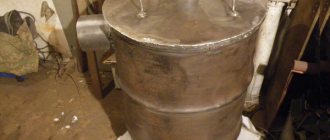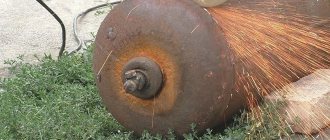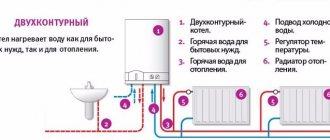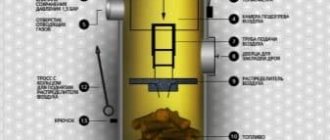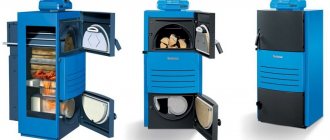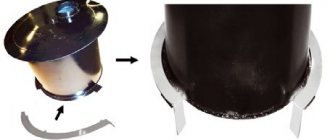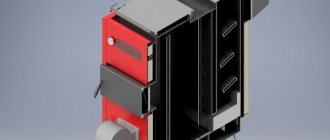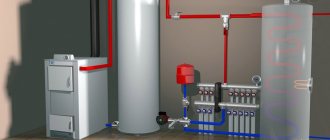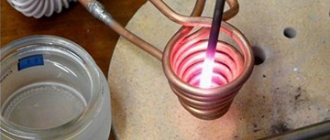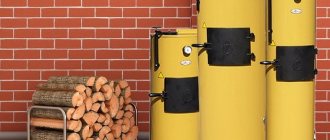A wood-burning boiler can be used as the main heating device. For houses located in areas where there is no centralized supply of natural gas and electricity, this choice will be optimal. If you make a long-burning wood-burning boiler with your own hands, you can save money. It will help maintain the required temperature in the room without frequent loading of fuel.
A long-burning boiler is a heating device that uses wood as a fuel resource.
Construction of a homemade long-burning boiler
A wood-burning unit with a water circuit that has high efficiency can be made with your own hands. Boilers are manufactured using two technologies - “Buleryan” and “Stropuva”. The difficulty of independently creating an installation operating on the Stropuva principle determines the low prevalence of such boilers.
Most units for heating private households are designed using the “buleryan” technology. The device consists of a housing, inside of which there are 2 cameras. In one of them the fuel smolderes, and in the second the gas coming from the first zone is burned.
The hatch for storing the energy carrier is made in the upper part of the device. The entire lower zone is a chamber into which firewood is loaded. At the top of the device there is a pipe for attaching the chimney. At the bottom there is an ash pit for waste. The collection compartment does not act as a blower. This is the difference between such boilers and classic stoves. The ash pan closes hermetically, and the air necessary for combustion enters through a chamber located in the upper part, which acts as a recuperator.
The volume of oxygen flow is regulated by a damper located at the top of the air chamber. As the fuel smolders, it slowly settles down along with the distributor and provides a continuous supply of air to the combustion area of the energy carrier. When laying firewood, you need to pull up this knot, returning it to its original position.
Due to complete combustion, a small amount of harmful substances enters the environment.
Construction of a homemade wood-burning boiler.
The main parts of the device are:
- combustion zone;
- gas afterburning chamber;
- ash pan;
- chimney
All structural components are located in a housing, for the manufacture of which you can use an old large gas cylinder or a metal sheet 5-6 mm thick.
The boiler has a large compartment for storing energy. The duration of operation of the equipment without refueling with firewood or coal depends on the size of the loading compartment.
Building a classic boiler
Long-burning furnace
It is necessary to start manufacturing a boiler with calculations and drawings, diagrams or, at a minimum, sketches. Calculations make it possible to determine the required power of the unit, and therefore to identify such important parameters as the volume of the firebox, the area of the heat exchanger, the volume of a single load, etc. Drawings can be found on the Internet or drawn yourself. To create a simple design, a small sketch may be enough.
The best option is to make a classic boiler. After all, it is extremely difficult to develop an effective and reliable pyrolysis boiler without experience and skills. The basis of the unit body can be a pipe or a welded structure made of sheet steel. It all depends on the availability of opportunities and the developed project.
The work is carried out in several stages:
- Welding the body.
- Making an air distributor. For this purpose, a small piece of pipe with a damper is welded in the upper part to regulate the air supply to the firebox. An additional impeller can be installed at the bottom of the distributor.
- Formation of the ash pit and firebox, installation of doors and other fittings.
- Installing the cover on the top of the housing.
- Installation of the finished boiler on a concrete foundation.
- Connection to the water circuit.
- Acceleration firebox.
If the design is done correctly, and there were no errors when connecting the unit to the fuel network, the accelerating furnace proceeds without problems. This means that the boiler can be operated without danger.
Accelerating firebox
Homemade from sheet steel
It is necessary to fire the boiler for the first time before the onset of the heating season - if errors are found, there will be time to correct them. Such a unit is capable of operating on any type of solid fuel. We choose the one that we plan to use constantly. Fuel is loaded through the top cover of the housing. The firebox must be filled to the level of the chimney. For better combustion, you can spray the load with a special lighter fluid.
Once loading is complete, the lid closes and the air supply regulator returns to its place. One of the disadvantages of this design is that it is impossible to remove the top cover without removing the air regulator.
Ignition is carried out through an open air damper using a burning splinter. Until the fuel begins to smolder confidently, the damper should remain open. Then she covers herself up a little. When the combustion rate decreases to a level insufficient for effective operation, the damper can be opened slightly. During the acceleration fire, the fuel in the boiler must completely burn out.
Types of equipment
Several types of boilers can be designed and assembled at home.
The most common designs are:
- mine;
- pyrolysis;
- bubafonya;
- buleryan.
The most common type is the shaft boiler.
The first type works due to lower combustion of fuel. The base of the boiler is a spacious chamber into which firewood or coal is loaded. The flame is not located in the compartment for storing the energy carrier, but in the adjacent compartment where a heat exchanger made of heat-resistant material is located.
The pyrolysis apparatus is distinguished by the presence of two chambers in which combustion occurs. In the first, thermal decomposition of the energy carrier occurs with a small amount of oxygen. As a result, flammable gas is formed and enters the afterburner chamber. An additional volume of air is supplied to it.
During the combustion process, a large amount of energy is released, which is absorbed by the water circulating in the heating system. There are different devices that differ in the location of the main structural components.
Buleryan boiler is a convection oven. The devices are equipped with powerful heat exchangers that allow you to quickly warm up a large area. These boilers can operate on one load of energy for about 10-12 hours. The volume of the combustion chamber in them is small.
Bubafonya is a stove modified into a hot water boiler. A special feature of the device is the supply of oxygen for fuel combustion from above under the action of a pressure piston.
Operating principle, advantages and disadvantages
The classic model of a solid fuel boiler can operate on one fill for 6-7 hours. If you do not add energy to the firebox after a specified period of time, the temperature begins to decrease.
The units are designed for 24-48 hours of operation at full load. The secret of long-term autonomous operation lies in the boiler design, which provides for the presence of 2 chambers. The first is intended for burning fuel when there is a lack of air, and in the second, the combustion of gases released during the thermal decomposition of firewood occurs.
Due to their large size, it is recommended to install boilers in large houses to create an optimal microclimate. Heating a small room with such a device will not be economically viable.
The main advantage of long-term storage boilers is their high efficiency.
The advantages of using homemade units are:
- high efficiency rate, which can reach 95%;
- autonomous functioning of the heating system;
- efficiency;
- high reliability and durability;
- energy availability;
- environmental friendliness;
- ability to function on any type of solid energy carrier.
In addition to the advantages, such installations have a number of disadvantages that should be taken into account.
The main disadvantages are:
- the bulkiness of a long-burning solid fuel boiler;
- complexity of installation operations;
- the need to allocate a special room for installation of the unit and regular cleaning of the ash pan.
You don't have to buy the device. If you have the appropriate knowledge and skills, it can be made independently.
Pyrolysis boilers
The operating principle of these heat generators is based on separate combustion in two chambers communicating with each other through a nozzle made of refractory bricks. In the primary chamber, located on top, firewood smolders with limited air supply from the fan. As a result, a process of pyrolysis occurs, otherwise known as gasification, during which a mixture of flammable gases is released. It moves to the second chamber, where it is burned when secondary air enters. The working diagram of a pyrolysis boiler operating on solid fuel is as follows:
Flue gases from the secondary furnace enter the fire tube heat exchanger in the form of vertical flues surrounded by a water jacket. There they cool, transferring heat to the water, and leave the boiler through the chimney pipe. The performance of the fan is controlled by an electronic unit - controller, based on the readings of pressure and temperature sensors.
In general, the heat generator has good efficiency indicators - about 80%, but the unit is significantly more expensive than a classic one. In addition, the boiler shows high efficiency only when operating on dry wood, although this statement is also true for other solid fuel units.
How to make a long-burning boiler with your own hands
The starting point in the manufacture of heating equipment is the choice of the type of installation and the development of drawings. To be able to operate the system on different types of solid fuel, the combustion chamber of the unit is made of heat-resistant alloy steel or grade 20 seamless metal pipe.
It is not difficult to make a boiler design at home.
If an old gas cylinder is used to construct the main chamber, then the operating time of the unit on one load of fuel can be 10-12 hours. This is due to the small volume of the combustion chamber. Therefore, to increase the operating time of the boiler, it is preferable to make the main compartment of the device from a pair of cylinders, having previously cut them off on both sides and welded them together into a single whole.
When constructing the unit with your own hands, you need to ensure that the ash pan door is tightly closed by sealing it with an asbestos cord to prevent additional portions of air from leaking into the combustion chamber. If the device is provided with another door for additional fuel loading, then it must also be sealed.
General overview of boilers available in design
A design feature of top-combustion boilers is the supply of air to the combustion site using a telescopic pipe. Making such a wood-burning unit with your own hands is not an easy task even for experienced craftsmen. For this reason, in most cases, homemade solid fuel long-burning boilers have traditional bottom combustion, and the operating time of the unit is achieved due to the increased volume of fuel and the connection of automatic regulators, which can be purchased separately and installed on any boiler. Fuel is loaded into such a unit through the upper hatch, and the lower hatch is intended for arson, through which combustion products are also cleaned out.
Air is supplied to the fuel chamber through the ash pan and grate bars; the air supply and combustion force are regulated using the ash chamber door. Depending on the design, the units are made from sheet steel 3–5 mm thick or from pipes with a diameter of at least 300 mm. Regular steel is suitable, but it is better to purchase heat-resistant steel or use a double layer of material. The role of a heat exchanger can be performed by either the walls themselves or the registers, or a combination of both.
The main task when creating such a unit with your own hands is to ensure the largest area of contact of the fuel with the surface of the heat exchanger, due to which the efficiency increases.
The simplicity of the design is ensured by the fact that the water circuit is in direct contact with the flame. However, it should be taken into account that a large amount of heat will still escape into the chimney, so you can additionally create a water heating device. To set it up you need two pipes of different diameters and some sheet steel. A larger pipe will serve as a container for water, and a pipe with a smaller diameter will act as a chimney and heating element.
A wood-burning mine-type boiler is more difficult to make with your own hands, but is characterized by high efficiency. Such units consist of two chambers - the first serves as a compartment for loading fuel, and the second, located on the side, contains a heat exchanger. When the fuel is ignited in the adjacent chamber, the flame and hot gases, due to draft, enter the chamber with the register and heat the coolant inside the pipes. Since the smoke travels a long way from the combustion site to its release into the atmosphere, it almost completely transfers heat to the register.
What is needed for this
To create a boiler with your own hands, you need to prepare a set of tools.
During the work you will need:
- welding machine;
- devices for metalworking;
- electric drill;
- level;
- roulette;
- ruler;
- marker for marking;
- Bulgarian.
To make a long-burning boiler, you need a welding machine.
The technician will need personal protective equipment in the form of gloves and goggles.
Additionally, you will need to prepare in advance the materials necessary for the construction of boiler equipment:
- 1 or 2 old gas cylinders;
- sheet steel 4-5 mm thick;
- asbestos cord for sealing compartment doors;
- metal pipe Ø 60 mm;
- hinges and door handles;
- steel corner;
- basalt fiber as a heat-insulating insulating layer.
People who know how to use welding and devices designed for metalworking can begin to develop and assemble the unit.
Difficult, but doable - burning fuel from top to bottom
Even using the example of an ordinary match, you can see for yourself the efficiency of combustion from top to bottom. A match in a vertical position with a flame below emits heat, which is enough to heat the thermometer to 60 ° C. If you turn the match over, due to the long burning, the thermometer can be heated to 120 °C. On the scale of a heating boiler, this principle ensures uniform and long-lasting combustion of the fuel, however, in this case, a water jacket is required that will cover the entire surface of the combustion chamber. Registers in such a design are not required, but their presence will add 5–10% to the overall efficiency of the boiler.
To make such a wood-burning boiler with your own hands, you will need a powerful grinder for cutting metal and another one for grinding work. However, it is better to cut the metal when purchasing it at a metal depot, since when cutting with a grinder there is a high probability of overheating the material at the cut site, which will cause it to become too brittle. You also need a good welding machine. Choose sheet metal with a thickness of at least 4 mm, preferably heat-resistant. You will also need several pipes, one with a diameter of 300 mm and a length of one and a half to two meters with a wall thickness of 3–4 mm and pipes with a diameter of 60 mm and 100 mm - the first for the air distributor, the second for the chimney.
Step-by-step manufacturing instructions
The boiler design process consists of several stages.
The main ones are:
- Marking the body and its assembly.
- Manufacturing of a chimney and its pipe.
- Design of the ash receiver compartment.
- Preparing the air supply device.
- Heat exchanger assembly.
- Installation of the unit.
The manufacture of the boiler takes place in several stages.
The result depends on the accuracy of the work at each stage. If all operations are performed in accordance with the drawings, this guarantees safe and long-term operation of the device.
Before installing the equipment and connecting it to the heating system, its operation is checked outdoors. In this case, a temporary pipe is connected to the chimney pipe.
Operating instructions: diagrams and drawings
Before starting work, a TT boiler project is prepared and drawings and sketches of individual elements of the device are drawn up. Before constructing the unit, the location of the gas afterburning zone is determined. It can be located both at the top and at the bottom.
In the first case, fuel smoldering products are directed to the afterburning area under the influence of natural forces, and in the second, by using an additional device for forcing air flow.
Drawing of a long-burning wood-burning boiler.
Heaters with a bottom-mounted afterburner are structurally complex units and require the installation of additional equipment. Therefore, devices with an upper gas afterburning zone are most often designed independently.
Alternative options – gas generation and pellets
Long-burning boilers include pyrolysis units, as well as boilers operating on pellets. Pyrolysis (gas generator) boilers are loaded with firewood every 8–12 hours. First, the fuel starts to ignite so that the temperature inside the boiler reaches 800 °C. At this temperature, gas generation becomes possible - with the help of valves, the desired mode is established, namely, the access of oxygen to burning wood is limited. As a result, wood gas is released, which burns in a special chamber, and only then the charcoal is burned. A minimal amount of ash and soot is formed. The efficiency of gas generator boilers is about 85%.
The main advantage of pyrolysis units is economical fuel consumption. Thanks to this, the heating season will cost you two to three times less than usual - this is how the high cost of such devices pays off. However, you will have to constantly struggle with another problem - a wood-burning boiler of this type only works effectively on very dry fuel or clean coal.
Pellet boilers with automatic fuel supply can operate indefinitely, the main thing is that the required amount of fuel is nearby. The structure of such units is practically no different from conventional solid fuel boilers, with the exception of automatic fuel supply. Domestic boilers have a container into which pellets are poured - one load is enough for several days. In general, servicing the unit will take about 20 minutes a week - this is enough to occasionally remove the ash and add fuel to the bunker.
What safety rules must be followed?
When making homemade installations, fire safety requirements must be observed.
These include:
- Control of thermal conditions inside the device.
- Prohibition of storing flammable materials near the boiler.
- Organization of a high-quality air circulation system in the boiler room.
A mandatory fire safety requirement is to install the device in a separate room.
How to check the boiler before starting
In accordance with the requirements of sanitary norms and regulations (SNIP), before starting the boiler, a hydrocheck of it and the heating system connected to the unit must be carried out for 24 hours.
For this:
- All taps are opened.
- The pipeline is filled with water.
- The pressure in the heating system is raised to 1.3 bar.
Using the procedure allows you to ensure that there are no leaks. During the inspection process, the condition of threaded and welded joints is monitored. The pressure in the system should not fluctuate throughout the day. If problems or leaks are detected, the boiler is disconnected from the main pipelines. Troubleshooting measures are being carried out.
Useful tips and tricks
In order for the heater to work for a long time without problems, you should follow some recommendations:
- The equipment is installed on a rigid concrete base. This eliminates subsidence and helps avoid loose connections between the unit and the main heating system pipes.
- When using homemade doors for the combustion and ash compartments, it is necessary to ensure tightness after closing them. This helps improve fuel combustion efficiency.
- The coolant transfer pump is mounted on the return line. With this installation, it operates in a lightweight mode, which will allow it to serve for 6 years or more.
- To prevent heat loss through the chimney, it must be equipped with a damper.
It is not recommended to use low-grade fuel as energy carriers. It provokes the appearance of smoke and forms ash and coal deposits on the internal structural elements of the unit.
